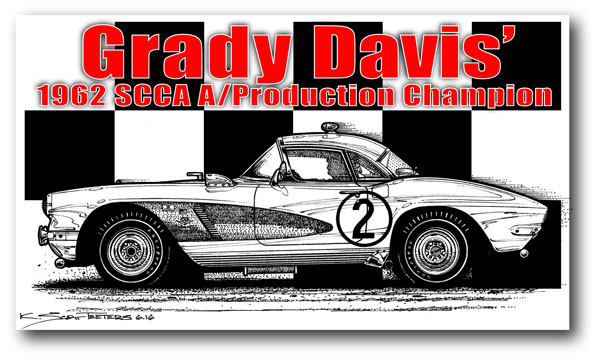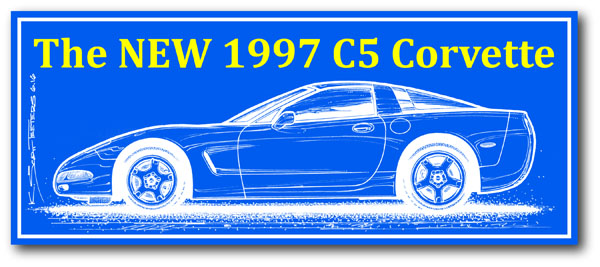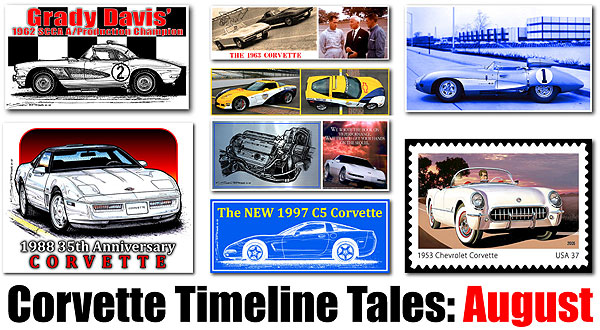Eight important Corvette events through the decades that happened in August.
This story was first published in the September 2016 issue of Vette Vues Magazine.
August 3, 2006 – All-New C6 Z06 serves as Pace Car for the Allstate Brickyard 400 at Indy
 2006 marked the 13th time a Chevrolet car paced the Brickyard 400, but it was the first time a Corvette served as the pace car for the series. Going all the way back to the 1978 Indy 500 Corvette Pace Car, powered by the 220-horsepower 350 L82 engine, off-the-line Corvettes have always had plenty of grunt and suspension to easily pace major races. The 2006 Z06 with its 505-horsepower LS7 was a thunderous beast compared to the ’78 Corvette Indy 500 Pace Car. But the common denominator between the two cars is that aside from the strobe lights, strobe light roof bar, and five-point racing harness, all Corvette pace cars are “off the line” Corvettes – abet thoroughly prepared for the task.
2006 marked the 13th time a Chevrolet car paced the Brickyard 400, but it was the first time a Corvette served as the pace car for the series. Going all the way back to the 1978 Indy 500 Corvette Pace Car, powered by the 220-horsepower 350 L82 engine, off-the-line Corvettes have always had plenty of grunt and suspension to easily pace major races. The 2006 Z06 with its 505-horsepower LS7 was a thunderous beast compared to the ’78 Corvette Indy 500 Pace Car. But the common denominator between the two cars is that aside from the strobe lights, strobe light roof bar, and five-point racing harness, all Corvette pace cars are “off the line” Corvettes – abet thoroughly prepared for the task.
One ironic tidbit is that the production C6 Z06 had a top speed of 198 mph. The average speed for the race was only 137.182 mph and the pole position speed was 182.778 mph. So, could a race-prepared, stock C6 Z06 last in a 500-mile race at the Brickyard? Sure! Could a race-prepared, stock C6 Z06 win against an all-out Indy car from 2006? Probably not, but it’s an interesting question. How would a 2006 C6.R Corvette stack up against an Indy car? Care to Bench Race a little?
August 5, 1961 – At the Wisconsin Grand Prix, Richard “The Flying Dentist” Thompson races Grady Davis’ Gulf Oil 1962 Corvette to a 1st place win in SCCA A/Production class
 It is mind-boggling how many early Corvettes were either ordered from the factory with the full-compliment of racer parts, unofficially known as “Duntov’s Racer Kits”, and/or, were built using the Racer Kit parts that were bolted on a Fuelie or dual-quad Corvette. Of course, just having the parts on the car, either factory or customer installed, didn’t instantly create a turn-key racecar – the cars had to be prepared for racing. Preparation and not over-building the engine, so it wouldn’t grenade, is also essential. The larger displacement 327 small-block used in the 1962 Corvette was enough to put the car into the A/Production class, whereas Grady Davis’ 1961 Corvette used a 283 Fuelie was in B/Production class. With Dr. Dick Thompson behind the wheel, Davis’ Fuelie Corvette won 12 out of 14 races. That’s an 85.7-percent win rate!
It is mind-boggling how many early Corvettes were either ordered from the factory with the full-compliment of racer parts, unofficially known as “Duntov’s Racer Kits”, and/or, were built using the Racer Kit parts that were bolted on a Fuelie or dual-quad Corvette. Of course, just having the parts on the car, either factory or customer installed, didn’t instantly create a turn-key racecar – the cars had to be prepared for racing. Preparation and not over-building the engine, so it wouldn’t grenade, is also essential. The larger displacement 327 small-block used in the 1962 Corvette was enough to put the car into the A/Production class, whereas Grady Davis’ 1961 Corvette used a 283 Fuelie was in B/Production class. With Dr. Dick Thompson behind the wheel, Davis’ Fuelie Corvette won 12 out of 14 races. That’s an 85.7-percent win rate!
Where it gets crazy is how many winning and championship Corvettes were retrofitted back to streetcars and then sold as daily drivers! Yes, many people owned these cars and did not know that their streetcar was once a fire-breathing racing car or racing champion. This happened to the three 1960 Briggs Cunningham Le Mans Corvette racers and the Grady Davis 1961 Corvette that won the SCCA B/Production Championship in 1961 and 1962!
Of course, finding these cars and then bringing them back to their glory days configuration is part of the thrill of these cars. In 2009 when the fully-restored Grady Davis 1962 Gulf One Corvette went to auction, it brought in a staggering $1,485,000! A few months before, the Grady Davis 1963 Gulf Oil Corvette sold at auction for $1,113,000. If you follow car auctions one thing is clear – the big bucks go to championship, celebrity, or super low-production cars. Even a “name” such as John Greenwood, by itself, isn’t enough. In 2015, Greenwood’s Sebring ’75 Corvette stalled out at auction at $300,000. The car was bloody fast and beautifully restored – but had no championship status in its lineage, so no big payday for the seller.
August 10, 1993 – Deep inside the inner sanctum of GM, the 1997 Corvette program begins the “Concept Alternatives Selection” process. It was time to justify the C5!
 Dave Hill was officially crowned as the third Chief Engineer for the Corvette on November 18, 1992 – talk about big shoes to fill! Duntov was a living legend even in the 1950s. Duntov’s successor, Dave McLellan had the challenge of redesigning Zora’s Corvette and delivered the very successful C4 Corvette. While C4s are today in the lower strata of Corvette desirability, there were many C4 brutes from 1984 to 1996. Noteworthy C4s include the ’90 to ’95 ZR-1s, the purpose-built Corvette Challenges racers, the Callaway Twin-Turbos, the Guldstrand G80, and G90 cars, the Tommy Morrison speed record holder ZR-1, and the astonishingly fast 1988, 254.7-mph Callaway Sledgehammer Corvette!
Dave Hill was officially crowned as the third Chief Engineer for the Corvette on November 18, 1992 – talk about big shoes to fill! Duntov was a living legend even in the 1950s. Duntov’s successor, Dave McLellan had the challenge of redesigning Zora’s Corvette and delivered the very successful C4 Corvette. While C4s are today in the lower strata of Corvette desirability, there were many C4 brutes from 1984 to 1996. Noteworthy C4s include the ’90 to ’95 ZR-1s, the purpose-built Corvette Challenges racers, the Callaway Twin-Turbos, the Guldstrand G80, and G90 cars, the Tommy Morrison speed record holder ZR-1, and the astonishingly fast 1988, 254.7-mph Callaway Sledgehammer Corvette!
So, Mr. Hill had the daunting task of pulling together the new design and then justifying the new Corvette’s existence. The “Concept Alternatives Selection” is where the engineers and bean counters go head-to-head. Virtually every part, procedure, and design layout was presented, defended, and decided on. The C5 program was provisionally passed, pending a two-week review of some components. Continue reading “Corvette Timeline Tales – August”

